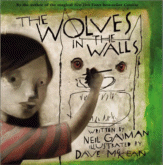The Wolves in the Walls
HarperCollins, August, 2003.
Hardcover, 56 pages.
ISBN: 038097827X
Ages 5 and up
 Lucy is a sensible girl and when she hears noises
coming from inside the walls - "sneaking, creeping
crumpling noises" - she knows it's the wolves. But her
mother and father dismiss her fears. For as everyone
knows, "If the wolves come out of
the walls, It's all over." Although no one ever explains
what "it" is, certainly "it's all over" sounds dire.
Her mom continues to make fresh strawberry jam and
her father continues to play his tuba, unaware of the
frightening events that are about to overtake their family.
For one night, the wolves do come out of the walls
(just as Lucy predicted) and the family ends up huddled
at the bottom of the garden, homeless. For the wolves are
eating all the strawberry jam, playing her dad's second-best
tuba and having a riotous party and generally making quite a nuisance
of themselves. It is up to Lucy to be the brave one and sneak
into the house to rescue her beloved pig puppet, who was left
behind in the rush to escape. After Lucy does some initial
reconnaissance, she convinces
her family to sneak into the walls of the house. Soon after,
they come out of the walls, and the wolves run
for their lives shouting, "Flee! For once the people come out
of the walls, it's all over."
Lucy is a sensible girl and when she hears noises
coming from inside the walls - "sneaking, creeping
crumpling noises" - she knows it's the wolves. But her
mother and father dismiss her fears. For as everyone
knows, "If the wolves come out of
the walls, It's all over." Although no one ever explains
what "it" is, certainly "it's all over" sounds dire.
Her mom continues to make fresh strawberry jam and
her father continues to play his tuba, unaware of the
frightening events that are about to overtake their family.
For one night, the wolves do come out of the walls
(just as Lucy predicted) and the family ends up huddled
at the bottom of the garden, homeless. For the wolves are
eating all the strawberry jam, playing her dad's second-best
tuba and having a riotous party and generally making quite a nuisance
of themselves. It is up to Lucy to be the brave one and sneak
into the house to rescue her beloved pig puppet, who was left
behind in the rush to escape. After Lucy does some initial
reconnaissance, she convinces
her family to sneak into the walls of the house. Soon after,
they come out of the walls, and the wolves run
for their lives shouting, "Flee! For once the people come out
of the walls, it's all over."
Neil Gaiman, bestselling author of American Gods, Coraline and The Day I Swapped My Dad for 2 Goldfish, has two little girls of his own and he knows how they think. His heroines, such as Coraline and Lucy, are intelligent children who work things out in their own way, in their own time. They tend not to scare easily and think that grownups do some very odd things indeed. Gaiman's children's books are meant to be read aloud: it is then that his true mastery of words, phrasing, sounds and rhythms becomes so apparent. Award-winning artist Dave McKean (probably best known for his work on Gaiman's Sandman series) does a marvelous job with the artwork, using mixed media: collages, photographs and scratchy pen and ink drawings for the scenes where the wolves run amok. He occasionally uses a four-panel style layout, borrowed from graphic novels which adds to the richness and depth of the story. In fact, the illustrations are quite scary, which make a nice contrast for the matter of fact tone that Gaiman uses to relate the inventive and creepy narrative.
Some themes are beginning to emerge from Gaiman's growing body of children's books: the intelligence of the child which is often ignored or overlooked by adults, the fact that many adults don't really listen to what children are saying, children's routine acceptance of things that adults would find frightening or bizarre, the fact that the world really is a pretty scary place and that bravery is something that will keep one in good stead throughout life. Neil Gaiman continues to surprise readers, not only with his prolificacy, but with his depth of talent.
--Claire E. White
The Wolves in the Walls is available for purchase on Amazon.com
Note: We may receive a commission from sales made through product links in this article.
This review was published in the September-October, 2003 of The Internet Writing Journal.
Copyright © Writers Write, Inc. All Rights Reserved.
